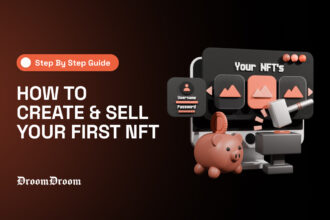NFTs refer to the blockchain representation and unique identities of various types of property as a new form of ownership in the ever-dynamic and volatile landscape of digital assets. The liquidity ability inherent in most NFTs goes further than what it takes to trade any digital art, collectibles, or virtual property. More and more, investors and collectors are moving into creative means in search of liquidity out of their NFTs without losing ownership of them. The quest for liquidity in the search for DeFi and blockchain functionalities has created an interesting link between technology and finance as people find ways of borrowing funds whilst retaining ownership of their valuable digital products.
- What is NFTs?
- What Does Liquidity of NFTs Mean?
- Ways to Liquidate NFTs Without Selling Them
- Borrowing crypto against NFT collaterals
- Deposit NFT into a vault and mint a token
- Fractionalize your NFT
- Renting out your NFT
- Non-fungible to fungible
- Advantages and Disadvantages of Liquidity of NFTs
- The Future of NFTs Liquidation
- Interoperability and Cross-Chain Solutions
- Integration with Traditional Finance
- Enhanced Fractionalization Models
- Innovative Collateralization Models
- Integration with Virtual and Augmented Reality (VR/AR)
- Expansion of Use Cases
- Conclusion
Unique digital assets authenticated by blockchain, with most NFTs created on platforms such as Ethereum, and known as Non-Fungible Tokens (NFTs). Liquidity is a term used to describe how quickly one can sell or buy an NFT in exchange for more practical kinds of value, like cash, among other assets.
This exploration of unusual financial approaches takes us on a fascinating journey into ways of getting liquidity from NFT without having to sell it straight forward. This guide explains various ways in which an NFT holder can obtain financial flexibility such as through collateralizing NFTs and using blockchain-based lending protocols. People’s awareness of those alternative mechanisms enables them to strategically manage their finances by choosing the right priorities so they make a connection between virtual and physical values.
What is NFTs?
Unique digital assets authenticated by blockchain, with most NFTs created on platforms such as Ethereum, and known as Non-Fungible Tokens (NFTs). In contrast to cryptocurrencies like Bitcoin or Ethereum, the NFT is considered evidence of possession or authentication of specific digital or real property items, including artworks, music, films, to virtual land, among others. The cryptographic signature of each NFT makes them non-interchangeable and identifiable as unique pieces.
First, blockchain guarantees an open-book record of ownership to certify the uniqueness and limited supply of the tokenized digital assets associated with them. People nowadays consider their purchase of NFTs as a way of supporting the creators while buying digital media, and in exchange, they want to own rare and verifiable objects that only exist digitally, but in the unregulated internet world. The rise in popularity of NTF has set about a cultural change and reinvented the notion of ownership and value in the digital era.
What Does Liquidity of NFTs Mean?
Liquidity is a term used to describe how quickly one can sell or buy an NFT in exchange for more practical kinds of value, like cash, among other assets. Their liquidity becomes an important issue because it is likely that many individuals intend to sell their NFTs while retaining ownership of the digital content. Innovative financial structures and decentralized platforms enable NFT holders to convert their unique possessions into liquid assets.
A common way of improving liquidity is collateralizing NFTs within DeFi protocols. Users can also use NFTs as collateral to obtain loans in the form of a cryptocurrency or stablecoin, with instant liquidity provided and NFT ownership retained. The other lane in this route comprises NFT-based lending platforms that offer credit facilities that enable users to borrow against their assets without necessarily disposing of such items and assets. These mechanisms give NFT holders a way to tap into liquidity so that they can engage in other investments and handle pressing financial matters.
Liquidity in the NFT space is the ease of converting uniquely represented digital assets into a form that can be used for the purchase or sale of other products. The innovative concepts continue to emerge as the NFT ecosystem develops which connects the online and economic circles dynamically.
Ways to Liquidate NFTs Without Selling Them
Achieving liquidity for NFTs does not necessarily require direct sale; such can be facilitated by strategic innovation and decentralized systems. Here are several ways to liquidate NFTs without parting with the underlying assets:
Borrowing crypto against NFT collaterals
Cryptocurrency borrowing utilizing NFT collateral serves as an innovative technique for tapping into the liquidity of non-fungible tokens (NFTs) that do not result in the sale of these unique digital assets. Therefore, NFT holders can use their digital collectibles in different DeFi platforms as they find new ways of making the most of their assets and earning more revenue.
Users can borrow cryptocurrency/stablecoin/or other forms of coins using collateralized NFT via smart contracts in platforms such as Aave and Makerdao. NFTs serve as securities, enabling access to financial resources without causing the underlying asset to be liquefied. Depending on the expected value of the collateral, the volume of borrowing is established, while users remain in possession until repayment.
The approach provides NFT owners with the liquidity they need to indulge in investments, pay debts, and join decentralized finance. Nevertheless, borrowers are required to comply with terms in the smart contracts including repayment rules and possible liquidation levels to avoid losing the NFT as collateral. Borrowing against NFTs would be a lucrative way to utilize digital asset management strategies as the DeFi space matures.
Deposit NFT into a vault and mint a token
The DeFi provides an advanced technique of depositing an NFT into a vault and minting a token upon the vault’s liquidation, enabling its owners to receive liquidity while maintaining ownership of the special digital assets. The process entails using blockchains to facilitate collateralization of NFTs within a decentralized vault, with its token being the representation of the NFTs’ ownership.
They become security for a loan or a token that goes by the name NFT-backed token or vault token when these NFTs are sent in the vault. The token is now tradable and can also be used in the rest of the DeFi Ecosystem, thereby making the smart contract an essential component of the vaults. The holder of the NFT keeps possession of the real NFT but can use the tokenized version for multiple applications.
This approach gives liquidity to those who are holding onto their treasured digital assets and allows them to engage in DeFi activities like yield farming and liquidity provision. Nonetheless, people need to have a clear picture of smart contract technologies, their consequences as well and the probability of being liquidated under certain circumstances so that they can pass through this new way of obtaining liquidity in an ever-changing world of blockchain finance.
Fractionalize your NFT
Splitting an NFT into smaller fractions is another way of releasing liquidity without giving up the whole asset. One of how an NFT can be fractionalized is by creating tradable fragments or tokens from a single ownership, with a piece of the asset remaining with the first owner.
Every fractional share constitutes part of the overall ownership interest that is associated with the underlying NFT which has been divided across various parties. Such types of fractionalized tokens can then be traded through platforms that support such a mechanism thereby giving liquidity to an NFT holder who can sell or trade fractions of an NFT but does not lose full ownership. Therefore, investors can acquire exposures at premium prices minus the huge acquisition costs of such assets.
Fractionalization eases the market for the NFTs but it gives people an opportunity to own high-class NFTs. These platforms such as fractional or Unicly act as intermediates in the fractionalization of NFTs and provide an alternative way to earn without letting go of the assets altogether. Nevertheless, users need to take into account possible platform fee schemes, forms of governance, and possible regulatory issues concerning this option.
Renting out your NFT
Selling an NFT is a conventional way of creating liquidity but renting one out is an innovative idea of creating liquidity from this asset. This approach allows NFT holders to tap into the expanding market of virtual real estate and digital products in the virtual world and the metaverses.
The owner of such an NFT allows another user to borrow it temporarily, use it, or exhibit it for a set period after paying a reasonable fee. The income is available instantly, and the owner of this NFT never gives up ownership. These arrangements are also facilitated most of the time by platforms that transact with either virtual real estate or the blockchain gaming environment.
It maintains ownership while conforming to the changing nature of the digital economy in which virtual places and properties have real monetary worth. Renting out NFTs is applicable, in particular, for virtual worlds, intending to have eye-catching and original objects that can help users enhance their online presence or experiences.
The market for renting NFTs will continue growing as the metaverse expands, making it an excellent source of income for NFT holders even in the future. Participants must define well-outlined rent terms and use smart contracts to support, verify, and authenticate the transaction.
Non-fungible to fungible
Uniquely, in tokenization, NFTs are converted into fungible tokens. Without relinquishing their underlying assets, it allows unlocking liquidity from NFT. Here, any NFT is represented in fungible token form, most commonly on a blockchain supportive of this process.
The holder may use tokenization to come up with fungible tokens where NFT is backing its worth. The owners of such fungible tokens can trade them or use them in DeFi protocols without losing their original digital assets as they remain the holders.
Tokenization enables holding part or fraction of this NFT’s monetary value and thus, involving this NFT in different kinds of financial affairs. The use of these fungible tokes in lending, borrowing, and yield farming helps to maximize on benefits of financing in that way a single piece becomes an item in multiple deals.
The participants will have to be cautious while choosing the terms and conditions of every tokenization platform as well as take into consideration the risks connected with this new method in the financial system based on blockchain technology.
Advantages and Disadvantages of Liquidity of NFTs
Advantages of Liquidity Without Selling NFTs
Asset Retention
Some advantages include retaining the assets of essential NFT and attaining liquidity at the same time. As a result, the NFT holders can benefit from the possibility that their digital assets will have value over a prolonged period.
Diversification
NFT holders are also able to apply liquidity strategies to diversify their asset portfolios and participate in DeFi, for example, in lending, staking, or yield farming practices.
Immediate Access to Funds
NFT holders enjoy instant liquidity as they do not have to wait for sales on conventional marketplaces. Thus, they can take advantage of time-specific investment opportunities and cover unanticipated costs.
Preservation of Rarity
The digital asset’s rarity and scarcity remain intact with this strategy since the entire NFT is not being sold. Additionally, it may contribute to higher future resale value.
Disadvantages of Liquidity Without Selling NFTs
Smart Contract Risks
Smart contracts are also employed in DeFi platforms and tokenization technologies, and they might have security loopholes. The NFT collateral may get ruined by malicious players or unknown technical difficulties.
Market and Platform Risks
The nascent nature of the NFT market and DeFi platforms may put the players in uncertainties and volatilities. The effectiveness of liquidity strategies is subject to platform failures and market downturns.
Complexity
Involving sophisticated liquidity procedures like pledged loans or tokens can be problematic to inexperienced or new customers because they necessitate expertise in blockchain technology as well as decentralized finance.
Liquidation Risks
With regards to cases involving collateralized loans, their NFT could be forfeited where its value goes down significantly.
The Future of NFTs Liquidation
As time progresses, blockchain and DeFi will advance, hence opening up new pathways of revolutionization in NFTs and their liquidation. Several trends and possibilities can shape the future landscape of NFT liquidity:
Interoperability and Cross-Chain Solutions
A probable future enhancement involves the instant transferability of NFTs coupled with their respective liquidity across various blockchain platforms. Cross-chain solutions will improve the accessibility and liquidity options of NFT holders.
Integration with Traditional Finance
With time when the regulating environment evolves, NFTs will likely integrate better in classical finance. It could create ways for issuing NFT-backed financial instruments with broader choices of liquidity for asset owners.
Enhanced Fractionalization Models
The fractionalization of those NFTs is likely to continue becoming more sophisticated thus enabling finer tokenizing of the NFT ownership. As a result, traders could buy or sell smaller slices of precious NFTs increasing their liquidity.
Innovative Collateralization Models
The demand will only increase for using NFTs as a security option in the financing tools employed by DeFi. Therefore, future models might include dynamic risk management and more advanced liquidation arrangements to compensate for possible market movements.
Integration with Virtual and Augmented Reality (VR/AR)
There is a possibility that NFTs can be applied in the virtual and virtual reality sectors which will lead to more ways of borrowing, renting, or using them in immersive settings hence resulting in other types of NFT liquidity.
Expansion of Use Cases
The possibility of non-art NFTs seems quite likely. Tokenization of real assets such as real estate, intellectual property, or business equity can create many innovative liquidity options in the real world.
With time, there will be more approaches to converting NFTs into capital both from users, developers, and platforms, which will form an intricate, but rich future of NFT liquidations. As time passes by, this convergence of decentralized finance (DeFi) and other emerging technologies will continue to impact the NFT market liquidity.
Conclusion
It is bound to be an interesting cross-linkage between advancement in technology and financial ingenuity as far as the future of NFTs and their liquidation without outright sales are concerned. On collateralized loans, tokenization and many more emerging trends such as cross-chain interoperability and real-world asset tokenization are revolutionizing decentralized finance strategy. There will be many ways of unlocking liquidity whilst preserving their hold through the matured blockchain ecosystem.



















